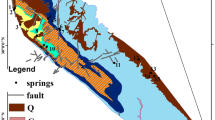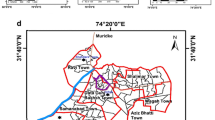Abstract
Groundwater extracted from shallow aquifers in the Bengal Delta is contaminated with arsenic. The fluviodeltaic process that creates aquifers, ironically, extends its role to also contaminating them with arsenic. The arsenic distribution maps show a spatial association of arsenic-contaminated wells with palaeo/cut-off/abandoned channels. Weight-on-evidences analysis indicates that the zones of contamination occur around palaeo-channels within a corridor of 500–700 m that contains most of the contaminated wells. These corridors are interpreted to be the zone of channel shifting. Contaminated wells represent point fractal geometry that can be separated into isolated points and clusters. Clusters occur within the zone of channel shifting as obtained by weight-on-evidences analysis. Isolated points occur within floodplain or back swamp areas. Clusters and isolated point fractals are interpreted to reflect the process of arsenic release into groundwater. The migration of biomass within the permeable sandy domain of channel deposits is proposed to be the predominant process in generating clusters. The isolated points represent restricted biomass spreading in less permeable clay-silt dominated floodplains.










Similar content being viewed by others
References
Acharyya SK, Lahiri S, Raymahashay BC, Bhowmik A (2000) Arsenic toxicity of groundwater in parts of the Bengal basin in India and Bangladesh: the role of quaternary stratigraphy and Holocene sea-level fluctuation. Environ Geol 39:1127–1137
Ahsan H, Perrum M, Rahman A, Parvez F, Stute M, Zhenz Y, Milton AH, Brandt Rauf P, Van Geen A, Grazino J (2000) Associations between drinking water and urinary arsenic levels and skin lesious in Bangladesh. J Occup Environ Med 12:1195–1201
Bolviken B, Stokke PR, Feder J, Jossang T (1992) The fractal nature of geochemical landscapes. J Geochem Explor 43:91–109
Bonham-Carter GF (1994) Geographic information system for geoscientists: modelling with GIS. Pergamon Press, New York
Bonham-Carter GF, Agterberg FP, Wright DF (1988) Integration of geological datasets for gold exploration in Nova Scotia. Photogramm Eng Remote Sens 54:1585–1592
Cheng Q (1999) The gliding box method for multifractal modeling. Comput Geosci 25:1073–1079
Feeder J (1988) Fractals. Plenum Press, New York
Gelman A, Treviscani M, Lu H, Van Geen A (2004) Direct data manipulation for local decision analysis as applied to the problem of arsenic in drinking water from tube-wells in Bangladesh. Risk Anal 24:1597–1712
Harvey CF, Swartz CH, Badruzzaman ABM, Blute NK, Ya W, Ali MA, Jenny J, Beckie R, Niedan V, Brabander D, Oates PM, Ashfaque KN, Islam S, Hermond HF, Ahmed MF (2002) Arsenic mobility and groundwater extractions in Bangladesh. Science 298:1602–1606
Lei X, Kusunose K (1999) Fractal structure and characteristic scale in distributions of earthquake epicenters, active faults, and rivers of Japan. Geophys J Int 139:754–762
Oremland RS, Stolz JF (2003) The ecology of arsenic. Science 300:939–944
Oremland RS, Stolz JF (2005) Arsenic, microbes and contaminated aquifers. Trends Microbiol 13:45–49
Pal T, Mukherjee PK, Sengupta S, Bhattacharyya AK, Shome S (2002) Arsenic pollution in groundwater of West Bengal, India – an insight into the problem by subsurface sediment analysis. Gondwana Res 5:501–512
Quillon G, Sornetto D (1996) Unbiased multifractal analysis: application to fault patterns. Geophys Res Lett 23:3409–3412
Quillon G, Sornetto D, Castaing C (1995) Organisation of joints and faults for 1 cm to 100 km scale revealed by optimized anisotropy wavelet coefficient method and multifractal analysis. Nonlinear Process Geophys 2:158–177
Sengupta S, Bhattacharya D, Mukherjee PK (2003) Nature and causes of arsenic contamination in groundwater from West Bengal Delta. In: Proc 7th Int Conf Biogeochem Trace Elements (Abstract). Uppsala, vol 2, pp 114–115
Sengupta S, Mukherjee PK, Pal T, Shome S (2004) Nature and origin of arsenic carriers in shallow aquifer sediments of Bengal Delta, India. Environ Geol 45:1071–1081
Swartz CH, Blute NK, Badruzzaman B, Ali MA, Brabander D, Jay J, Besancon J, Islam S, Hermond HF, Harvey CF (2004) Mobility of arsenic in a Bangladesh aquifer: inferences from geochemical profiles, leaching data and mineralogical characterization. Geochem Cosmochem Acta 68:4539–4557
Turcotte DL (1997) Fractals and chaos in geology and geophysics, 2nd edn. Cambridge University Press, Cambridge
Van Geen A, Protus T, Cheng Z, Seddique AA, Hoque MA, Ahmed KM (2004) Testing groundwater for arsenic in Bangladesh before installing a well. Environ Sci Technol 38:6783–6789
Author information
Authors and Affiliations
Corresponding author
Rights and permissions
About this article
Cite this article
Mukhopadhyay, B., Mukherjee, P.K., Bhattacharya, D. et al. Delineation of arsenic-contaminated zones in Bengal Delta, India: a geographic information system and fractal approach. Environ Geol 49, 1009–1020 (2006). https://doi.org/10.1007/s00254-005-0139-3
Received:
Accepted:
Published:
Issue Date:
DOI: https://doi.org/10.1007/s00254-005-0139-3




